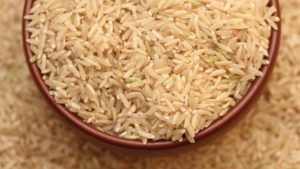All foods are made up of three macronutrients (carbohydrate, fat, and protein), that provide energy, and a variety of micronutrients (vitamins and minerals) that perform essential functions in the body. By selecting the right proportion of a variety of choices from whole, unprocessed foods, you can ensure that you are obtaining a healthy balance of macro and micronutrients. Learn more information about these nutrients below:
Jump to: Carbohydrates | Dietary Fats | Protein | Vitamins | Minerals | Antioxidants & Phytonutrients
CARBOHYDRATES

Many diet trends demonize “carbs,” but it’s important to remember that carbohydrates are the primary energy source for the body especially the brain and nervous system. Overall, it is recommended that calories from carbohydrates, specifically complex carbohydrates, make up about half of the calories you consume daily.
FUNCTION
Once consumed, all carbohydrates are digested into glucose, and then absorbed into the bloodstream to be transported throughout the body. Glucose is the primary energy for all body cells and needs to be in constant supply in the blood stream. Blood glucose levels rise after a meal and then fall back after the glucose is delivered to the cells.
Once the immediate needs of the body have been met, excess glucose is stored in the liver as glycogen. This serves as an “emergency reserve” in case blood glucose levels drop too low, but it can only sustain the body for less than one day. When carbohydrates, or any other energy-providing foods, are consumed in excess, the body will store this extra energy as body fat.
TYPES OF CARBOHYDRATES
Carbohydrates are classified as simple or complex based upon their chemical structure, which affects how quickly the molecules are digested and absorbed.
Simple carbohydrates consist of one or two sugar molecules bonded together. Because they are small, simple sugars require little digestion and are rapidly absorbed. Although this can be beneficial for a quick burst of energy, foods and beverages containing simple carbohydrates often lack nutrients and frequent consumption of these foods can contribute to insulin resistance. These types of carbohydrates occur naturally in foods such as fruit and milk, but unfortunately are added to many processed foods.
Food sources include:
- Table sugar (sucrose)
- High fructose corn syrup
- Fruit sugar (fructose)*
- Milk sugar (lactose)*
- Other sugars (honey, molasses, brown sugar, syrups, agave)
- Candies, pies, cakes, cookies
- Beverages that include added sugars
*While fruit and milk do contain simple sugar, they can also be a rich source of other nutrients and can be part of a healthy diet.
Complex carbohydrates such as those found in fiber have three or more sugar molecules and must be broken down into simple carbohydrates before the body can absorb and metabolize the energy. Foods high in complex carbohydrates are recommended because they provide sustained energy and are often higher in vitamin, minerals, and fiber, which provide additional health benefits. Some complex carbohydrates are more refined than others, often resulting in a lower nutritional value, so stick with unrefined carbohydrates for the most nutrient-rich options.
Unrefined carbohydrate sources include:
- Whole grains such as brown rice, oats, whole wheat berries, quinoa, barley, whole grain pastas, breads and cereals, bulgur, and bran
- Beans and legumes
- Starchy vegetables such as potatoes, sweet potatoes, winter squash, and corn
- Other vegetables (broccoli, cauliflower, carrots, mushrooms, cucumbers, etc.) also contain complex carbohydrate, just in smaller amounts, when compared to more starchy vegetables
Refined carbohydrates such as white flour have been milled to remove bran and germ. Although they contain complex carbohydrates, many of the benefits have been removed through processing and most also contain added simple carbohydrates, such as sugar.
Food sources include:
- Bread made with white flour
- Pasta made with white flour
- Baked goods made with white flour
- Many processed crackers and snacks
- White rice
When deciding about what carbohydrate sources to include in your diet choose reasonable portions of unrefined carbohydrates and include fruits and vegetables at all your meals and snacks.
DIETARY FATS

Contrary to popular belief that “fat is bad,” dietary fat plays an essential role in our bodies. Overall, fats should comprise about one-third or less of the calories you consume daily, mostly in the form of healthy unsaturated fats. Tran’s fats should be avoided.
FUNCTION
Fat is critical to the absorption of nutrients such as fat soluble vitamins A, D, E and K, brain function, and heart health. Fat also sends satiety cues to our brains that tell us we are full, insulates and cushions the body, and adds flavor to our food.
TYPES OF DIETARY FATS
All fats are not created equal. There are many structural differences in individual fats, and it’s good to make a few distinctions.
Unsaturated Fats, both polyunsaturated and monounsaturated, are found primarily in plant foods and are good for heart health and cholesterol levels. Unsaturated fats also include Omega-3s, a fat group that is essential to heart health.
Food sources include:
- Plant-based oils such as olive, canola, sunflower, safflower, corn, and soy
- Avocados
- Nuts, seeds, and their oils
- Fish, including salmon and sardines
Saturated Fats are often found in animal products and can raise your “bad” cholesterol levels and increase the risk of heart disease.
Food sources include:
- The fat in animal proteins*
- Dairy products (except non-fat)
- Tropical oils including palm and coconut
*Most animal products have both saturated and unsaturated fat. Grass-fed beef has a higher ratio of unsaturated fat than beef fed a grain-based diet.
Trans Fats occur as a result of a process called “hydrogenation” resulting in qualities that are desirable in food manufacturing such as a higher melting point or a longer shelf life. However, Tran’s fats increase the risk of coronary heart disease. Health authorities recommend that consumption of Tran’s fat be reduced to trace amounts. Given the health risks, the FDA has banned the use of added trans-fat in all foods by 2018.
Until that time common food sources include:
- Many packaged snack foods
- Many fried foods
- Many commercial baked goods
- Most margarine and shortening
Look for the words hydrogenated or partially hydrogenated on nutrition labels. Trans fats must be labeled as such, making them easier to avoid. However the FDA definition for “trans fat free” allows up to .5 g of this fat per serving so it’s best to avoid foods with these ingredients altogether.
PROTEIN
Protein is essential because it provides structure for many parts of the body. Our bones, skin and hair are made of collagen—a mix of proteins and minerals. Protein also provides energy and is vital for maintaining muscle mass. About 20% of your daily calories should come from protein.
FUNCTION
Proteins are composed of amino acids, the “building blocks” of protein.
There are 20 amino acids, nine of which are considered “essential”, meaning that the body can’t produce them, so they need to be obtained through food. Protein eaten at each meal does not get directly used by the body. Instead, it is digested and broken down into amino acids that are absorbed and transported throughout the body. Individual amino acids are then used to build the body’s essentials, ranging from enzymes and hormones to collagen and antibodies.
FOOD SOURCES
Protein from animal sources is almost always “complete protein”, which means that the food contains all nine essential amino acids. Although plant-based sources of protein are usually lacking in one or more essential amino acids, or “incomplete,” it is possible to obtain all of the essential amino acids needed by eating a variety of plant-based sources of protein. It is also important to keep in mind that plant-based sources of protein such as beans and legumes, nuts, and whole grains, are often accompanied by other healthy nutrients and fiber.
ANIMAL FOOD SOURCES OF PROTEIN
- Meat, fish, shellfish, poultry
- Eggs
- Dairy products (milk, cheese, yogurts)
PLANT-BASED FOOD SOURCES OF PROTEIN
- Beans and legumes
- Nuts
- Whole grains
- Soy products (complete protein)
- Vegetables (minimal amounts of protein)
COMPLEMENTARY PROTEINS
When two sources of plant-based protein are lacking in different amino acids, but together provide all nine essential amino acids, they are considered to be “complementary.” Contrary to popular belief, complementary proteins do not have to be consumed at the same time to provide the benefits of all nine essential amino acids.
VITAMINS

Vitamins are organic compounds obtained from plants and animals that are required in small amounts.
FUNCTION
Vitamins are essential for the function of practically every organ in the body.
Whether absorbed directly from foods, or stored by the body for later use, vitamins are a critical part of a balanced diet. The body can’t make vitamins. Different foods contain different vitamins, so it’s essential to consume a variety of healthy foods.
TYPES OF VITAMINS
Water-soluble vitamins include all B vitamins (thiamin, riboflavin, niacin, B6, B12), vitamin C and folate. They are essential for many metabolic processes to occur. By definition, water-soluble vitamins can exist freely in water so once food is digested, they are absorbed directly into the bloodstream and transported to cells throughout the body. These vitamins are stored in small quantities in the body.
Fat-soluble vitamins include vitamins A, D, E and K. They cannot exist freely in water, but need certain carriers (lipoproteins) for transport in the blood to various parts of your body. They are then stored in fat cells throughout your body and used when needed.
Food Sources
- Fresh fruits and vegetables of many colors and types
- Whole grains, legumes, nuts and healthy oils
MINERALS
Minerals are inorganic compounds absorbed by plants from water and soil. Small amounts of minerals are as important to our diet as vitamins. Each one has a specific job to perform—from cellular functions to building our teeth and bones.
TYPES OF MINERALS
Major minerals that are found in large quantities in our bodies include calcium, phosphorous, sodium and potassium.
Trace minerals are found only in minute quantities and include iron, zinc, copper, iodine and selenium.
FUNCTION
Minerals help with both bone formation and the maintenance of healthy fluid and electrolyte balance.
Minerals form the building blocks of strong bones and play a role in transmitting nerve impulses. Some minerals play a part in the manufacture of the body’s hormones and are needed to maintain a normal heartbeat.
When people don’t get enough of critical minerals, they can have health problems. For instance, too little calcium can lead to weaker bones, and too little potassium can lead to poor muscle function. One exception is sodium, which is linked with hypertension and cardiovascular problems and should be consumed in limited amounts. Most people don’t need mineral supplements if they eat a nutritious diet.
FOOD SOURCES
Calcium
- Vegetables – dark leafy greens, broccoli
- Fruit – oranges, papaya
- Nuts and seeds
- Beans and legumes
- Dairy products – milk, yogurt, cheese
- Fish with soft bones – anchovies, sardines
- Fortified soy products
Phosphorus
- Dairy products – milk, yogurt, cheese
- Meat, poultry, fish
- Eggs
- Nuts
Iron
- Meat, poultry, fish, shellfish
- Beans, lentils, pumpkin seeds
- Enriched breads and cereals
- Green leafy vegetables
Potassium
- Fruits and vegetables
- Yogurt and dairy products
- Legumes
- Fish and fresh proteins
Sodium
Americans should reduce their sodium intake to less than 2,300mg per day, or less than 1,500mg per day for individuals age 51 and older, those with hypertension, diabetes, or chronic kidney disease, and African Americans.
ANTIOXIDANTS AND PHYTONUTRIENTS

Antioxidants are unique nutrient compounds such as certain vitamins, minerals, and various phytonutrients that protect and repair cells from free radical damage, or oxidation. This protection may decrease the risk for many health problems including heart disease, cancer, diabetes, and arthritis. Phytonutrients are essentially “plant-nutrients” that exert beneficial effects such as repairing damage to cells, helping build our immune system, and acting as antioxidants.
TYPES OF ANTIOXIDANTS & PHYTONUTRIENTS
Antioxidants are usually phytonutrients, which means most antioxidants are obtained from plant foods. Phytonutrients may also be antioxidants, if this is how they function, but there are other phytonutrients that work in different ways.
Phytonutrients act as a protective shield around plants, and we are just beginning to learn that there are hundreds, even thousands of phytonutrients that may also help us in similar ways. Color is indicative of the amount and type of phytonutrient that a food contains so try to “eat a rainbow” of different fruits, vegetables, and other foods in order to obtain a high level and variety of antioxidants in your diet.
FOOD SOURCES OF ANTIOXIDANTS AND PHYTONUTRIENTS
Boost your antioxidant intake by choosing a variety of brightly colored foods from the lists below:
| Red |
| Tomatoes, red peppers, onions, pink grapefruit, watermelon, and guava. These foods contain Vitamin C and lycopene, which has been shown to reduce risk of heart and lung disease and prostate cancer. |
| Purple/Red/Blue |
| Apples, beets, berries, eggplant, grapes, and plums. These foods contain catechins, beta carotene, resveratrol, and anthocyanins, which strengthen skin, tendons and ligaments, as well as prevent blood clots from forming. |
| Orange |
| Bell pepper, papaya, sweet potato, and carrots. These foods contain Vitamin C and carotenoids, which prevent oxidation damage, reduce multiplication of cancer cells and eliminate tumors. |
| Orange/Red |
| Apricots, cantaloupe, winter squash, citrus, mango, nectarines, and peaches. These foods contain Vitamin C and carotenoids, which prevent oxidation damage, reduce multiplication of cancer cells and eliminate tumors. |
| Yellow |
| Corn, egg, summer squash, seeds, and nuts. These foods contain Vitamin A, lutein, and selenium, which protects against DNA damaging free radicals, cancer, and infections. |
| Green |
| Broccoli, chard, kale, collards, spinach, and green peas. These foods contain beta carotene, Vitamins C and E, and lutein, which promote healthy vision and reduce cancer risk. |
| Brown |
| Beans, brown rice, nuts, seeds, tea, and wheat germ. These foods contain selenium, Vitamins C and E, and catechins, which defend the body against cancer, heart disease and also have antibacterial action. |
| White |
| Garlic, oatmeal, onion, and seafood. These foods contain selenium, which protects against DNA damaging free radicals, cancer, and infections.
For more information about basic nutrition check out: |
Disclaimer: This information is not intended to take the place of advice from a health professional. Check with your physician before starting any diet or exercise program. While all efforts have been made to ensure the information included in this material is correct, new research is released frequently and may invalidate certain pieces of data. March 2016